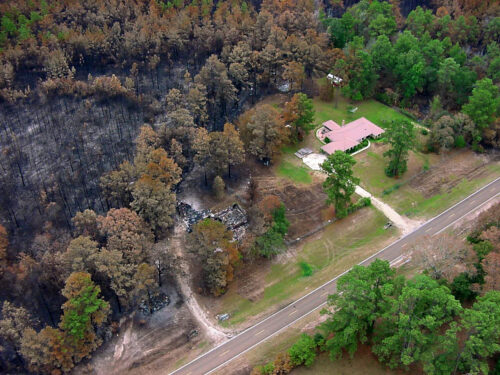 The key to protecting your property is defensible space. The good news is that there are actions you can take to create defensible space and reduce your risk.
The key to protecting your property is defensible space. The good news is that there are actions you can take to create defensible space and reduce your risk.
Defensible space is an area around a structure where fuels and vegetation are treated, cleared, or reduced to slow the spread of wildfire towards the structure. It also reduces the chance of a structure fire moving from the building to the surrounding forest. Defensible space provides room for firefighters to do their jobs. A house is more likely to withstand a wildfire if grasses, brush, trees, and other common forest fuels are managed to reduce a fire’s intensity.
Creating an effective defensible space involves developing a series of management zones in which different treatment techniques are used. Develop defensible space around each building on your property. Include detached garages, storage buildings, barns, and other structures in your plan.
The actual design and development of a home’s defensible space depends on several factors: size and shape of buildings, materials used in their construction, the slope of the ground on which the structures are built, surrounding topography, and sizes and types of vegetation on the property.
Take action now to protect your property.
Additional guidance on protecting property from wildfire is available from any local Virginia Department of Forestry representative or fire department.
Additional Resources
| Image | Title | ID | Description | Date | Content Type | View | hf:tax:document-category | hf:tax:Media |
|---|---|---|---|---|---|---|---|---|
| Firewise Communities for Virginia | P00111 | Brochure provides important steps to protecting your home and community from wildfire, including firewise landscaping, defensible space, fire-resistant roof and exterior construction, fire-resistant attachments, steps to becoming a firewise community, a disaster plan, defensible space, and emergency access. Printed copies available. | 12/31/2021 | Publication | View | fire-and-emergency-response | publication | |
 | Home Wildfire Safety Checklist – Is Your Home Firewise? | FT0002 | Forestry topic information sheet provides a checklist of items to answer about your home to assist in identifying characteristics of your home that may require changes to improve the wildfire safety of your home. | 08/01/2014 | Publication | View | fire-and-emergency-response | publication |
 | Is Your Home Safe from a Wildfire | Publication providing guidance on protecting homes from wildfire hazards. Printed copies available. | 01/01/2011 | Publication | View | fire-and-emergency-response | publication | |
| Firewise Landscaping Part 1: Overview | Video providing an overview of Firewise landscaping practices for wildfire protection. Part 1 of 3. | Video | View | fire-and-emergency-response | video | |||
| Firewise Landscaping Part 2: Design and Installation | Video covering design and installation techniques for Firewise landscaping. Part 2 of 3. | Video | View | fire-and-emergency-response | video | |||
| Firewise Landscaping Part 3: Maintenance | Video covering maintenance practices for Firewise landscaping. Part 3 of 3. | Video | View | fire-and-emergency-response | video |
Contact Us
For more information or questions, e-mail us or use our contact form.
